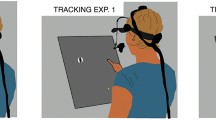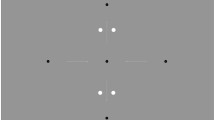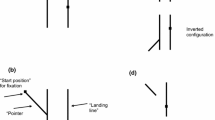Abstract
There are time delays in visuomanual and oculomotor pathways, and some of these time delays may be due to the finite time required to process visual motion signals and to extract accurate information about the speed and direction of the motion. The present experiments were designed to ascertain the time required to obtain a reliable estimate of the direction of target motion. Subjects were asked to indicate the final direction of a moving target, which abruptly changed direction and shortly thereafter disappeared, by pointing to its expected emergence at the boundary of an occlusion. Subjects made small but consistent errors that overestimated the target’s change in direction. These errors depended little on the amount of time the target was visible (ranging from 50 to 400 ms) after it changed direction. Pointing direction was strongly correlated with gaze, which was dominated by a saccade initiated shortly after the target changed direction. The pointing errors were explained by the fact that the saccade always intercepted the (occluded) target, but then continued in the same direction toward the boundary of the occlusion. The analysis reveals that target direction was estimated accurately even at the shortest viewing time.










Similar content being viewed by others
References
Coëffé C, O’Regan JK (1987) Reducing the influence of non-target stimuli on saccade accuracy: predictability and latency effects. Vision Res 27:227–240
Engel KC, Soechting JF (2000) Manual tracking in two dimensions. J Neurophysiol 83:3483–3496
Engel KC, Soechting JF (2003) Interactions between ocular motor and manual responses during two-dimensional tracking. Prog Brain Res 142:141–153
Engel KC, Anderson JH, Soechting JF (1999) Oculomotor tracking in two dimensions. J Neurophysiol 81:1597–1602
Findlay JM (1982) Global visual processing for saccadic eye movements. Vision Res 22:1033–1045
Gardner JL, Lisberger SG (2001) Linked target selection for saccadic and smooth pursuit eye movements. J Neurosci 21:2075–2084
Gnadt JW, Bracewell RM, Andersen RA (1991) Sensorimotor transformation during eye movements to remembered visual targets. Vision Res 31:693–715
Guthrie BL, Porter JD, Sparks DL (1983) Corollary discharge provides accurate eye position information to the oculomotor system. Science 221:1193–1195
Heeger DJ, Simoncelli EP, Movshon JA (1996) Computational models of cortical visual processing. Proc Natl Acad Sci U S A 93:623–627
Krauzlis RJ, Lisberger SG (1994) Temporal properties of visual motion signals for the initiation of smooth pursuit eye movements in monkeys. J Neurophysiol 72:150–162
Leigh RJ, Zee DS (1991) The neurology of eye movements. FA Davis, Philadelphia, PA
Lisberger SG, Westbrook LE (1985) Properties of visual inputs that initiate horizontal smooth pursuit eye movements in monkeys. J Neurosci 5:1662–1673
Masson GS, Stone LS (2002) From following edges to pursuing objects. J Neurophysiol 88:2869–2873
Maunsell JH, Van Essen DC (1983) Functional properties of neurons in middle temporal visual area of the macaque monkey. I. Selectivity for stimulus direction, speed, and orientation. J Neurophysiol 49:1127–1147
Mays LE, Sparks DL (1980) Saccades are spatially, not retinocentrically, coded. Science 208:1163–1165
Morris EJ, Lisberger SG (1987) Different responses to small visual errors during initiation and maintenance of smooth-pursuit eye movements in monkeys. J Neurophysiol 58:1351–1369
Movshon JA, Adelson EH, Gizzi MS, Newsome WT (1986) The analysis of moving visual patterns. In: Chagas C, Gattass R, Gross C (eds) Pattern recognition mechanisms. Springer, Berlin, Heidelberg, New York, pp 148–164
Newsome WT, Paré EB (1988) A selective impairment of motion perception following lesions of the middle temporal visual area (MT). J Neurosci 8:2201–2211
Newsome WT, Wurtz RH, Dursteler MR, Mikami A (1985) Deficits in visual motion processing following ibotenic acid lesions of the middle temporal visual area of the macaque monkey. J Neurosci 5:825–840
Optican LM, Quaia C (2002) Distributed model of collicular and cerebellar function during saccades. Ann N Y Acad Sci 956:164–177
Pavel M, Cunningham H, Stone V (1992) Extrapolation of linear motion. Vis Res 32:2177–2186
Poulton EC (1974) Tracking skill and manual control. Academic, New York
Quaia C, Lefevre P, Optican LM (1999) Model of the control of saccades by superior colliculus and cerebellum. J Neurophysiol 82:999–1018
Raiguel SE, Xiao DK, Marcar VL, Orban GA (1999) Response latency of macaque area MT/V5 neurons and its relationship to stimulus parameters. J Neurophysiol 82:1944–1956
Rashbass C (1961) The relationship between saccadic and smooth tracking eye movements. J Physiol (Lond) 159:326–338
Recanzone GH, Wurtz RH (1999) Shift in smooth pursuit initiation and MT and MST neuronal activity under different stimulus conditions. J Neurophysiol 82:1710–1727
Robinson DA (1972) Eye movements evoked by collicular stimulation in the alert monkey. Vision Res 12:1795–1808
Soechting JF, Engel KC, Flanders M (2001) The Duncker illusion and eye-hand coordination. J Neurophysiol 85:843–854
Soechting JF, Mrotek LA, Flanders M (2003) Time constants in the perception of a change in the direction of motion in humans. Neurosci Lett 348:56–60
Sparks DL (1986) Translation of sensory signals into commands for control of saccadic eye movements: role of primate superior colliculus. Physiol Rev 66:118–171
Sparks DL (2002) The brainstem control of saccadic eye movements. Nat Rev Neurosci 3:952–964
Sparks DL, Lee C, Rohrer WH (1990) Population coding of the direction, amplitude, and velocity of saccadic eye movements by neurons in the superior colliculus. Cold Spring Harb Symp Quant Biol 55:805–811
Stanford TR, Sparks DL (1994) Systematic errors for saccades to remembered targets: evidence for a dissociation between saccade metrics and activity in the superior colliculus. Vision Res 34:93–106
Weber H, Latanov A, Fischer B (1993) Context dependent amplitude modulations of express and regular saccades in man and monkey. Exp Brain Res 93:335–344
White JM, Sparks DL, Stanford TR (1994) Saccades to remembered target locations: an analysis of systematic and variable errors. Vision Res 34:79–92
Zivotofsky AZ, Rottach KG, Averbuch-Heller L, Kori AA, Thomas CW, Dell’Osso LF, Leigh RJ (1996) Saccades to remembered targets: the effects of smooth pursuit and illusory stimulus motion. J Neurophysiol 76:3617–3632
Acknowledgements
We would like to thank an anonymous reviewer for suggesting the control experiment. This work was supported by NIH grant EY-13704. LAM was supported by NSF-IGERT training grant 9870633.
Author information
Authors and Affiliations
Corresponding author
Rights and permissions
About this article
Cite this article
Mrotek, L.A., Flanders, M. & Soechting, J.F. Interception of targets using brief directional cues. Exp Brain Res 156, 94–103 (2004). https://doi.org/10.1007/s00221-003-1764-2
Received:
Accepted:
Published:
Issue Date:
DOI: https://doi.org/10.1007/s00221-003-1764-2




